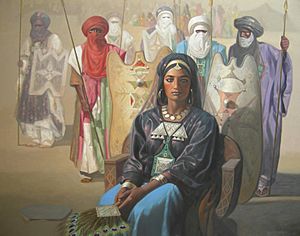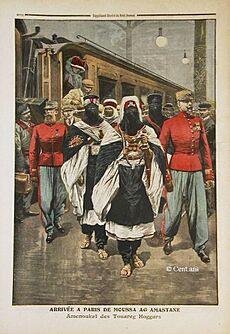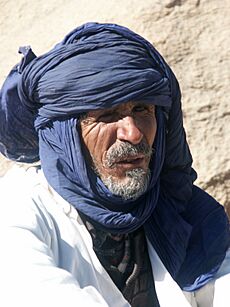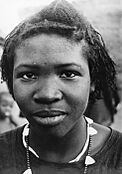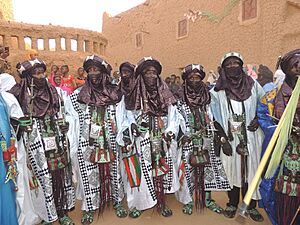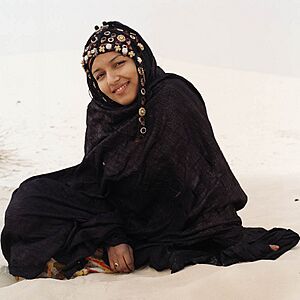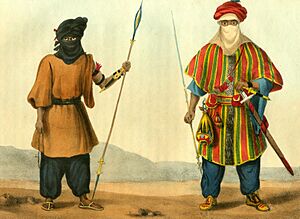Tuareg people facts for kids
| Imuhăɣ/Imašăɣăn/Imajăɣăn ⵎⵂⵗ/ⵎⵛⵗⵏ/ⵎⵊⵗⵏ |
|
|---|---|
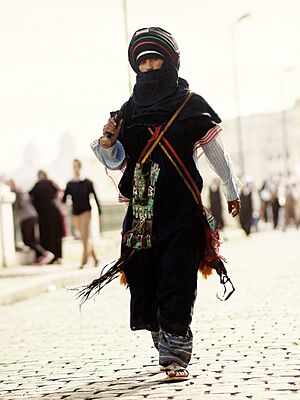
A Tuareg in Algiers, Algeria.
|
|
| Total population | |
| c. 4.0 million | |
| Regions with significant populations | |
| 2,793,652 (11% of its total population) | |
| 704,814 (1.7% of its total population) | |
| 406,271 (1.9% of its total population) | |
| 100,000–250,000 (nomadic, 1.5% of its total population) | |
| 152,000 (0.34% of its total population) | |
| 123,000 (2.6% of its total population) | |
| 30,000 (0.015% of its total population) | |
| Languages | |
| Tuareg languages (Tamahaq, Tamasheq/Tafaghist, Tamajeq, Tawellemmet), Maghrebi Arabic, French (those resident in Niger, Mali and Burkina Faso), Hassaniya Arabic (those residing in Mauritania, Mali, and Niger), English (those resident in Nigeria), Algerian Saharan Arabic (those residing in Algeria and Niger) | |
| Religion | |
| Predominately Sunni Islam | |
| Related ethnic groups | |
| Other Berbers, Arab-Berbers and Arabized Berbers, Songhay people, Hausa people | |
The Tuareg people are a large Berber group. They traditionally live as nomads and herders. You can find them mainly in the Sahara desert. Their lands stretch across parts of Libya, Algeria, Niger, Mali, Burkina Faso, and northern Nigeria.
The Tuareg speak their own languages, also called Tamasheq. These languages are part of the Berber family. Most Tuareg people follow the Islamic faith. They are known for their unique culture and history.
Contents
Who Are the Tuareg People?
The word Tuareg might come from Tārgi, meaning "inhabitant of Targa". Targa is a Tuareg name for a region in Libya. It means "(drainage) channel" in the Berber language. Another idea is that it comes from an Arabic word, Tuwariq.
Tuareg men call themselves Amajagh, meaning "freemen". Women are called Tamajaq. These words show their pride in being free. They also call themselves Kel Tamasheq, meaning "speakers of Tamasheq". Another name is Kel Tagelmust, which means "veiled people". This refers to the special cloth men wear over their faces.
People sometimes call them the "Blue People". This is because their indigo-colored veils and clothes can stain their skin blue.
Where Do the Tuareg Live?
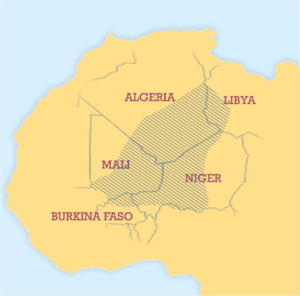
Today, the Tuareg live in a huge area of the Sahara desert. This includes parts of Libya, Algeria, Niger, Mali, Burkina Faso, and northern Nigeria. There are more than 2.5 million Tuareg people in these areas. About 2 million live in Niger and half a million in Mali.
The Tuareg traditionally speak their own languages. These are known as Tamasheq, Tamajeq, or Tamahaq. They are part of the Berber language family. About 1.2 million people speak Tuareg languages.
A Look at Tuareg History
Early Beginnings of the Tuareg
Long ago, the Tuareg moved south from the Tafilalt region into the Sahel. This was led by their founding queen, Tin Hinan. She is thought to have lived between the 4th and 5th centuries. Her ancient tomb is in the Sahara, in southern Algeria. Old writings from the Tuareg's traditional script, Tifinagh, have been found there.
People have written about the Tuareg since at least the 10th century. Travelers like Ibn Hawkal and Ibn Battutah described them. They often called them "the veiled ones" because of their face coverings.
Tuareg During Colonial Times
In the 1800s, Tuareg lands were organized into groups called confederations. Each was led by a supreme Chief, called an Amenokal. These groups were sometimes called "Drum Groups" because the drum was a symbol of the Chief's power. There were seven main confederations.
- Kel Ajjer: around Ghat, Libya.
- Kel Ahaggar: in the Ahaggar mountains.
- Kel Adagh: around Kidal and Timbuktu.
- Iwillimmidan Kel Ataram: in Mali.
- Iwillimmidan Kel Denneg: in Niger.
- Kel Ayr: around Assodé and Agadez.
- Kel Gres: around Zinder and into northern Nigeria.
- Kel Owey: in the Aïr Massif.
In the late 1800s, the Tuareg fought against the French who were trying to take over their lands. Tuareg swords were no match for French firearms. After many battles, the Tuareg were defeated. They had to sign treaties with the French in the early 1900s.
The French often supported the existing Tuareg leaders. They wanted to rule through these chiefs, letting them keep some power. This meant that the French rule did not change the lives of the lower social groups much.
Tuareg After Colonial Times
When African countries became independent in the 1960s, Tuareg lands were split. They became parts of Niger, Mali, Algeria, Libya, and Burkina Faso. This led to problems and conflicts. There were strict rules on their nomadic way of life. Also, the desert was growing, and resources were becoming scarce. This forced some Tuareg to try farming or find jobs in cities.
There have been several Tuareg rebellions since the 1960s. They fought for more control over their traditional homelands. Peace agreements were made in the 1990s. These agreements aimed to give more power to local areas and include Tuareg fighters in national armies.
However, some fighting continued. In Niger, Tuareg people still face challenges. They are often poor and not well represented in the government.
Tuareg Beliefs and Faith
The Tuareg traditionally had their own ancient beliefs. Over time, they adopted Islam after it arrived in the 7th century. By the 16th century, they mainly followed the Sunni branch of Islam. The Tuareg helped spread Islam further into the Western Sudan region.
Even after becoming Muslim, some old beliefs and rituals stayed in their culture. This is especially true among Tuareg women. They also have a strong "cult of the dead," which is a way of honoring their ancestors.
Timbuktu, an important Islamic city, was once protected and ruled by a Tuareg group. Later, Tuareg scholars helped spread Islamic teachings.
How Tuareg Society Works
Tuareg society has always had different groups and social levels. These include nobles, religious leaders, craftspeople, and formerly, enslaved people.
Tuareg Family Groups
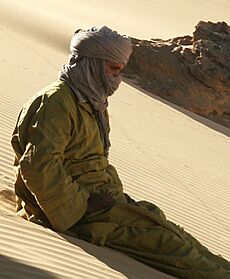
Tuareg society is made up of clans called tawshet. Each clan has family groups and is led by a chief, the amghar. Several clans can join together under an Amenokal to form a larger group called a Kel confederation. For example, Kel Dinnig means "those of the east".
The position of amghar is passed down through the mother's side of the family. This means a sister's son might become the next chief. This way of passing down leadership is an old tradition from before Islam.
Social Groups in Tuareg Society
Traditionally, Tuareg society had different levels. The highest group was the nobles, known as imušaɣ or "the proud and free". They were the warriors and owned camels. They also collected payments from other groups. Nobles usually married within their own group.
Below the nobles were the vassal-herdsmen, called ímɣad. They were free but did not own camels. They raised goats, sheep, and oxen. They also cared for the nobles' animals. They paid a yearly tribute to the nobles. Over time, they also became warriors.
Religious leaders, called marabouts or Ineslemen, were also an important group. They were Muslim scholars and judges. They helped spread Islam among the Tuareg.

Craftspeople and Farmers
Tuareg craftspeople are called Inhăḍăn. They are blacksmiths, jewelers, woodworkers, and leather artisans. They make and fix tools, saddles, and household items. They also make beautiful jewelry like the Agadez Cross. These craftspeople often work for noble families.
Singers, musicians, and storytellers are also part of Tuareg society. They are called Agguta. They keep the Tuareg oral traditions alive by singing at ceremonies.
Farmers who live in oases are called izeggaghan. They work the land and give some of their crops to the nobles who own the land. These farmers have mixed with freed slaves over time.
Slavery in Tuareg History
Historically, Tuareg groups acquired enslaved people through raids or trade. These enslaved communities were called Ikelan or Bellah. Their status was passed down through families. They often lived in separate communities and spoke the same language as the Tuareg nobles. They mainly cared for livestock.
French colonial governments tried to stop the trade of enslaved people. However, they did not always free those who were already enslaved. Even after countries became independent, some traditional relationships continued. Today, slavery is outlawed, and efforts are being made to end it completely.
Tuareg Culture and Traditions

Tuareg culture has many unique parts. These include their clothing, food, language, arts, and music.
Tuareg Clothing Style
In Tuareg culture, women do not usually cover their faces. However, men traditionally do. The most famous Tuareg clothing item is the tagelmust. This is a turban and veil combined, often indigo-blue. Men start wearing it when they become adults. It covers most of their face, leaving only their eyes and the top of their nose showing. This veil is believed to protect against evil spirits and the harsh desert sands.
Some traditional clothing items are:
- tagelmust: turban for men.
- tasuwart: women's veil.
- takatkat: shirt for women and men.
- akarbey: pants for men.
- ighateman: shoes.
- iragazan: red leather sandals.
What Do Tuareg People Eat?
Tagella is a flatbread made from wheat flour. It is cooked right on a charcoal fire, buried under hot sand. People break it into small pieces and eat it with meat sauce.
A common food is millet porridge, called a cink. It is boiled with water and eaten with milk or a thick sauce. Goat and camel milk are popular drinks. They also make cheese called ta komart and a thick yogurt called tona. Eghajira is a special drink for festivals. It is made from millet, goat cheese, dates, milk, and sugar.
Like in Morocco, the Tuareg drink a lot of sweet green tea. It is poured from high up into small glasses to create a froth.
Tuareg Languages and Poetry
The Tuareg speak their own languages, which are part of the Berber family. These languages are called Tamasheq, Tamahaq, or Tamajeq, depending on the region.
The Tuareg create a lot of poetry. It often talks about love, sadness, or short, clever sayings. Many of these poems have been written down and translated.
Tuareg Art and Jewelry
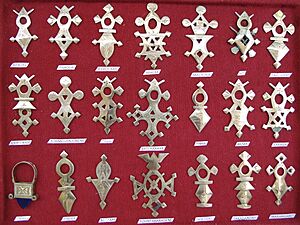
Tuareg art includes beautiful jewelry made from silver, colored glass, or iron. Unlike some other cultures, Tuareg men also wear necklaces, amulets, and rings.
These crafts are made by special artisans called inadan wan-tizol. They create items like:
- tanaghilt or zakkat: the famous 'Agadez Cross'.
- takoba: the Tuareg sword.
- takaza: gold and silver necklaces.
- tizabaten: earrings.
The Agadez Cross is a very important symbol. It is worn as a pendant and has become a symbol of Tuareg culture and rights. Today, many of these items are made for tourists.
Tuareg Nomadic Homes
Tuareg groups are famous for their nomadic homes, which are tents. There are different styles of tents, some covered with animal skin, others with mats. The style often depends on the region.
A tent is traditionally built for the first time during a wedding. It is seen as part of the marriage itself. The phrase "making a tent" is a way of saying "getting married." The tent is usually owned by the married woman.
Tuareg Traditional Weapons
Historically, the Tuareg were known as strong warriors. Their traditional weapons included:
- takoba: a long, straight sword (1 meter).
- sheru: a long dagger.
- telek: a short dagger worn on the left forearm.
- allagh: a long lance (2 meters).
- tagheda: a small, sharp spear.
- agher: a shield made of antelope hide (1.5 meters high).
Their military power changed when firearms became common, as the Tuareg did not have them.
Tuareg Music and Dance
Traditional Tuareg music has two main parts. The anzad is a one-string violin, often played at night. The tende is a small drum covered with goatskin. It is played during camel and horse races and other parties.
Traditional songs called Asak and Tisiway (poems) are sung by both women and men during celebrations. Another popular style is Takamba, which has strong African drum beats.
Vocal Music
- tisiway: poems.
- tasikisikit: songs sung by women, with the tende drum. Men on camels circle the women as they sing.
- asak: songs with the anzad violin.
Children's Music
- Bellulla: songs made by children playing with their lips.
- Odili flute: made from sorghum plant stems.
Dance
- Tagest: a seated dance, moving the head, hands, and shoulders.
- Ewegh: a strong dance for men, done in pairs or groups.
In the 1980s, a famous Tuareg band called Tinariwen started. They mix electric guitars with traditional Tuareg music. They became very popular, especially during the Tuareg rebellion. Other Tuareg guitar groups like Group Bombino followed them.
Music Festivals

You can experience Tuareg culture and music at festivals. The Festival in the Desert in Mali is one example. Other festivals include:
- Cure Salee Festival in In-Gall, Niger.
- Sabeiba Festival in Djanet, Algeria.
- Takubelt Tuareg Festival in Mali.
- Ghat Festival in Libya.
Tuareg Games and Fun Activities
Tuareg children and young people play many traditional games:
- Tiddas: played with small stones and sticks.
- Kelmutan: a singing game where players are out if their leg is touched.
- Temse: a funny game where you try to make the other team laugh.
- Izagag: played with small stones or dried fruits.
- Tabillant: traditional Tuareg wrestling.
- Tammazaga: camel racing.
- Sellenduq: a tag game where one person is a jackal.
- Takadant: children try to guess what others are thinking.
- Tabakoni: a clown with a goatskin mask who amuses children.
- Abarad Iqquran: a small wooden puppet that tells stories.
- Mifa Mifa: a beauty contest for girls and boys.
Tuareg Economy and Trade
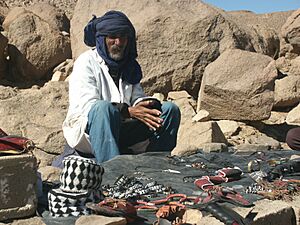
Many Tuareg today are farmers or nomadic animal breeders. Some are blacksmiths or lead camel caravans. Their economy is based on raising animals, trading, and farming.
Desert Caravans
For thousands of years, Tuareg people have organized caravans to trade across the Sahara desert. These caravans use camels to transport goods. They travel to salt mines in the desert, like:
- Tin Garaban in Libya.
- Amadghor in Algeria.
- Taoudenni in Mali.
- Fachi and Bilma in Niger.
Today, there are new economic challenges. In Niger, much of the land where Tuareg live has rich uranium deposits. The government controls this mining, which causes tension with the Tuareg. Uranium mining also uses a lot of water, which is scarce in the desert. This can harm the environment and Tuareg grazing lands.
Images for kids
-
A Tuareg man in Mali with his slave, 1974
-
Tuareg blacksmith
See also
 In Spanish: Tuareg para niños
In Spanish: Tuareg para niños


